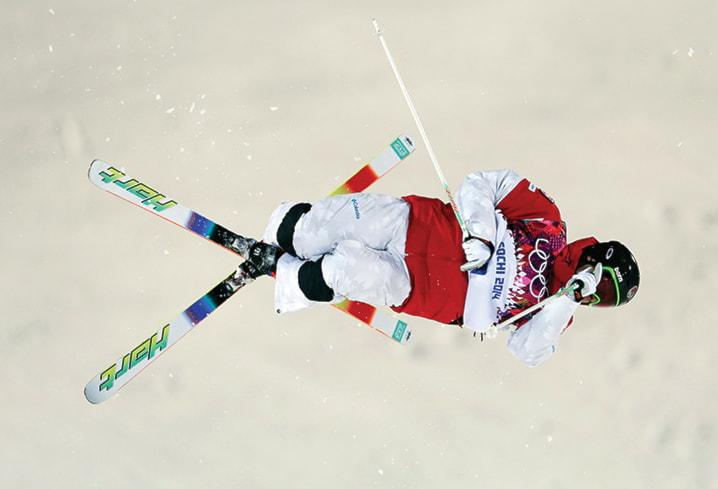It looks cool and most Canadians can do it no matter where they live. Those are fundamental reasons for the Canada’s early domination in freestyle skiing at the 2014 Winter Olympics.
Six of the country’s first nine medals in Sochi were won by moguls and slopestyle skiers. More are expected in halfpipe and skicross.
You don’t need mammoth mountains to produce a top freestyle skier. Canada has moguls and terrain parks at small resorts across the country.
It is there young skiers learn air awareness that is the foundation of the Olympic freestyle disciplines — moguls, aerials, skicross, halfpipe and slopestyle.
“Especially back east there are small mountains either in Quebec or Ontario,” says Jean-Luc Brassard, Canada’s 1994 Olympic moguls champion and Canada’s assistant chef de mission in Sochi.
“You easily have a moguls trail or a snow park. Since they’re not that high, you do a lot of repetitions. You do a lot of practice automatically.
“If I was born out west, probably I would have been a downhill skier or a free skier that loves powder because this is your playground and what you get when you walk out of your door.”
There’s a video-game element to some of the freestyle moves that appeals to teenage daredevils.
“When you look at it as a kid, it’s like a pinball machine and it’s fun,” Brassard explains. “It sounds fun to you. It looks attractive. When you’re a kid you want to climb a tree, you want to do flips. Plus we have colourful suits. It’s quite fashionable.”
The wider the base, the higher the peak of the pyramid. Canada is strong in hockey, curling and freestyle in Sochi because so many people back home do it.
“In Canada, that’s a tough thing to pry kids out of hockey and soccer and some of these other monolithic, huge megasports that chew up a lot of the athletic gene pool,” says Peter Judge, the chief executive officer of the Canadian Freestyle Ski Association.
“So we’ve been lucky that way to be able to — we’ll call it a harvest — some significant athletes out of the gene pool in Canada.”
Canada was ready with talent every time a new freestyle discipline was incorporated into the Winter Games: moguls in 1992; aerials in 1994; skicross in 2010; slopestyle and halfpipe in 2014.
That talent hasn’t always produced a medal, but more often than not, more than one Canadian has been in the hunt in a single event.
When favourite Kaya Turski of Montreal struggled in slopestyle qualifying Tuesday, Dara Howell of Huntsville, Ont., and Quebec City’s Kim Lamarre came through with gold and bronze.
Five Canadians made moguls finals and produced four medals. Montreal sisters Justine and Chloe Dufour-Lapointe won gold and silver respectively in the women’s event. Alex Bilodeau of Rosemere, Que., and Mikael Kingsbury of Deux-Montagnes, Que., duplicated the 1-2 finish in men’s moguls and Bilodeau defended the gold medal he won in 2010.
The skicross team is consistently on the international podium and medals could come from Marielle Thompson of Whistler, B.C., Kelsey Serwa of Kelowna, B.C., Dave Duncan of London, Ont., Montreal’s Chris Del Bosco or Brady Lehman of Calgary.
Mike Riddle of Sherwood Park, and Justin Dorey of Vernon, B.C., headline a deep men’s halfpipe team with Calgary’s Roz Groenewoud and Edmonton’s Keltie Hansen medal prospects on the women’s side.
Multiple medal chances are lacking in aerials, but Travis Gerrits of Milton, Ont., is a contender there.
As X Games ratings increased, it was only a matter of time before the International Olympic Committee incorporated more television-friendly freestyle events into the Winter Games.
The freestyle association was getting ready to form halfpipe and slopestyle teams, with Own The Podium providing seed money, even before the IOC gave its stamp of approval.
“We were able to turn the key and start the car as soon as we got the word they were official,” Judge says. “There was no two-year or three-year lag time, which would have clearly I think eliminated at least one if not both of the medals that we got at women’s slopestyle the other day.”
The athletes in the new sports were already talented and successful in the X Games and on their sports’ circuits. The CFSA and OTP provided the same medical and sport science and research support that athletes in established sports received.
“Since it’s become an Olympic sport, the things that have changed for me is the support behind me,” Riddle says. “We have a national team so we have access to trainers, doctors. In that regard, it has changed, but my daily on-hill schedule hasn’t changed at all. I’m still just out there trying to have fun and learning new tricks.”
Said Howell: “We kind of walked into a really good program, a solid program. They really do get behind us and want to see us do the best we can. The program they have in place is clearly working.”
Success breeds success and more than one Canadian athlete on the current freestyle team points to Brassard’s win in 1994 as their inspiration for getting into freestyle skiing.
